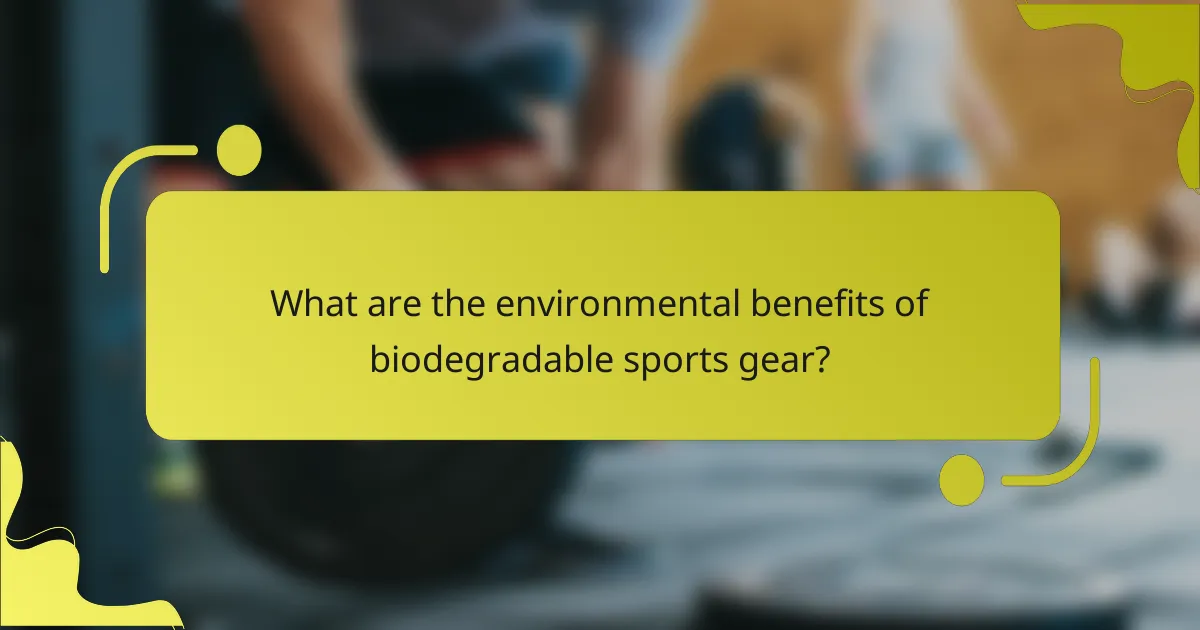Biodegradable sports gear significantly reduces environmental impact by minimizing waste and pollution. This article explores the advantages of biodegradable materials, such as organic cotton and hemp, and their role in sustainable manufacturing. It also examines the rapid growth of the biodegradable sports gear market, driven by consumer demand and innovative practices. Finally, we address the challenges manufacturers face in production and consumer education.

What are the environmental benefits of biodegradable sports gear?
Biodegradable sports gear significantly reduces environmental impact by minimizing waste and pollution. These products decompose naturally, unlike traditional materials that persist for decades. They help lower carbon footprints and decrease landfill contributions. Additionally, biodegradable gear often uses sustainable materials, promoting eco-friendly manufacturing practices. This shift supports a growing market trend towards sustainability in sports equipment, appealing to environmentally conscious consumers.
How does biodegradable sports gear reduce waste?
Biodegradable sports gear significantly reduces waste by breaking down naturally, minimizing landfill impact. This gear is made from materials like plant-based polymers and natural fibers, which decompose within a few months to years. Traditional gear, often made from plastics, can take hundreds of years to degrade, contributing to environmental pollution. Market growth in biodegradable sports gear reflects increasing consumer awareness and demand for sustainable products, promoting eco-friendly practices in athletics.
Why is biodegradability important in sports equipment?
Biodegradability is crucial in sports equipment as it reduces environmental impact and waste. Biodegradable sports gear minimizes plastic pollution, promoting sustainability. Materials like plant-based polymers and natural fibers decompose efficiently, unlike traditional materials. As the market for eco-friendly products grows, consumers increasingly seek biodegradable options, aligning with environmental values.

Which materials are commonly used in biodegradable sports gear?
Common materials in biodegradable sports gear include organic cotton, hemp, Tencel, and polylactic acid (PLA). These materials offer eco-friendly alternatives to traditional synthetics, reducing environmental impact while maintaining performance. Organic cotton is soft and breathable, hemp is durable and resistant to mold, Tencel is known for its moisture-wicking properties, and PLA is derived from renewable resources.
What are the properties of plant-based plastics in sports gear?
Plant-based plastics in sports gear are biodegradable, reducing environmental impact. They offer flexibility, durability, and lightweight properties, making them suitable for various sporting applications. These materials often include polylactic acid (PLA) and polyhydroxyalkanoates (PHA), which decompose naturally over time. Their growing popularity in the market reflects increased consumer demand for sustainable products, aligning with the eco-friendly trend in sports equipment.
How do natural fibers compare to synthetic materials?
Natural fibers offer superior biodegradability compared to synthetic materials, making them more environmentally friendly. Natural fibers, such as cotton and hemp, decompose within months, while synthetic materials like polyester can take hundreds of years to break down. Additionally, natural fibers are often more breathable and comfortable for active wear. However, synthetic materials provide durability and moisture-wicking properties that enhance performance in sports gear. The market for biodegradable sports gear is growing, driven by increasing consumer demand for sustainable options.

How is the market for biodegradable sports gear evolving?
The market for biodegradable sports gear is rapidly evolving due to increasing environmental awareness. Consumers demand sustainable alternatives, prompting brands to innovate with eco-friendly materials. The global biodegradable sports gear market is projected to grow significantly, driven by factors like reduced environmental impact and regulatory support. Key materials include plant-based plastics and natural fibers, which offer competitive performance while minimizing waste. As a result, brands that prioritize sustainability are gaining market share and attracting environmentally-conscious athletes.
What trends are driving growth in this market?
Growing environmental awareness and demand for sustainable options drive the biodegradable sports gear market. Consumers increasingly prioritize eco-friendly materials, influencing manufacturers to innovate. The rise of regulations promoting sustainability also propels market growth. Additionally, advancements in biodegradable materials enhance performance, appealing to environmentally conscious athletes.
Which companies are leading the way in biodegradable sports gear?
Leading companies in biodegradable sports gear include Adidas, Puma, and Nike. These brands focus on sustainable materials and innovative designs. Adidas has introduced shoes made from ocean plastic, while Puma emphasizes plant-based materials. Nike is developing biodegradable alternatives for its footwear. The market for biodegradable sports gear is expanding as consumers demand eco-friendly options.

What challenges do manufacturers face in producing biodegradable sports gear?
Manufacturers face several challenges in producing biodegradable sports gear, including material sourcing, performance standards, and consumer acceptance. Sourcing sustainable materials can be complex and costly. Additionally, ensuring that these materials meet performance standards, such as durability and moisture-wicking, is crucial for athlete satisfaction. Consumer education is also necessary, as many are unaware of the benefits of biodegradable options. The market’s growth hinges on overcoming these hurdles to increase adoption and innovation in sustainable sports gear.
How do production costs impact the availability of biodegradable options?
Production costs significantly influence the availability of biodegradable sports gear. Higher production costs can limit manufacturers’ ability to offer these sustainable options. This impacts market growth, as consumers may face limited choices or higher prices. As technology advances, production costs may decrease, potentially increasing the availability of biodegradable materials. For instance, innovations in plant-based polymers could lead to more affordable options, enhancing market competitiveness.
What are the regulatory hurdles for biodegradable sports gear?
Regulatory hurdles for biodegradable sports gear include compliance with environmental standards, material safety assessments, and certification processes. Manufacturers must navigate complex regulations that vary by region, impacting production timelines and market entry. Additionally, consumer awareness and demand for sustainable products influence regulatory frameworks, pushing for stricter guidelines.

How do consumers perceive biodegradable sports gear?
Consumers perceive biodegradable sports gear positively, valuing its environmental benefits and sustainability. Many appreciate its potential to reduce waste and pollution. As awareness grows, market demand for eco-friendly options increases, influencing purchasing decisions. Brands that emphasize biodegradable materials gain a competitive edge, appealing to environmentally conscious consumers.
What factors influence purchasing decisions for eco-friendly sports gear?
Purchasing decisions for eco-friendly sports gear are influenced by sustainability awareness, product performance, and brand reputation. Consumers increasingly prioritize environmental impact, seeking biodegradable materials that reduce waste. Market growth is driven by innovations in sustainable materials and the rising demand for ethical products. Transparency in sourcing and production processes also plays a crucial role, as consumers prefer brands that align with their values.
How can brands effectively market biodegradable products?
Brands can effectively market biodegradable sports gear by emphasizing sustainability, performance, and consumer awareness. Highlighting the environmental benefits, such as reduced waste and lower carbon footprints, resonates with eco-conscious consumers. Utilizing materials like organic cotton and recycled plastics showcases innovation. Engaging in educational campaigns about biodegradability and certifications builds trust. Collaborating with athletes and influencers can amplify brand visibility and credibility. Additionally, leveraging social media platforms for storytelling enhances brand connection with target audiences.
What are common misconceptions about biodegradable sports gear?
Many believe biodegradable sports gear decomposes quickly in all environments, which is not always true. Misconceptions include the idea that all biodegradable materials break down in landfills, while some require specific conditions like industrial composting. Another myth is that biodegradable gear is less durable, but advancements in materials have enhanced their performance. Additionally, some consumers think biodegradable gear is significantly more expensive, though prices are becoming competitive as the market grows. Understanding these misconceptions can help consumers make informed choices about sustainable sports equipment.
What best practices should consumers follow when choosing biodegradable sports gear?
Consumers should prioritize sustainability, material quality, and brand transparency when choosing biodegradable sports gear. Look for certifications that validate biodegradability claims. Consider the performance characteristics of materials, such as durability and moisture-wicking properties. Research brands committed to ethical practices, as this often correlates with higher-quality biodegradable options. Lastly, evaluate the life cycle of the product to ensure it aligns with your environmental values.




